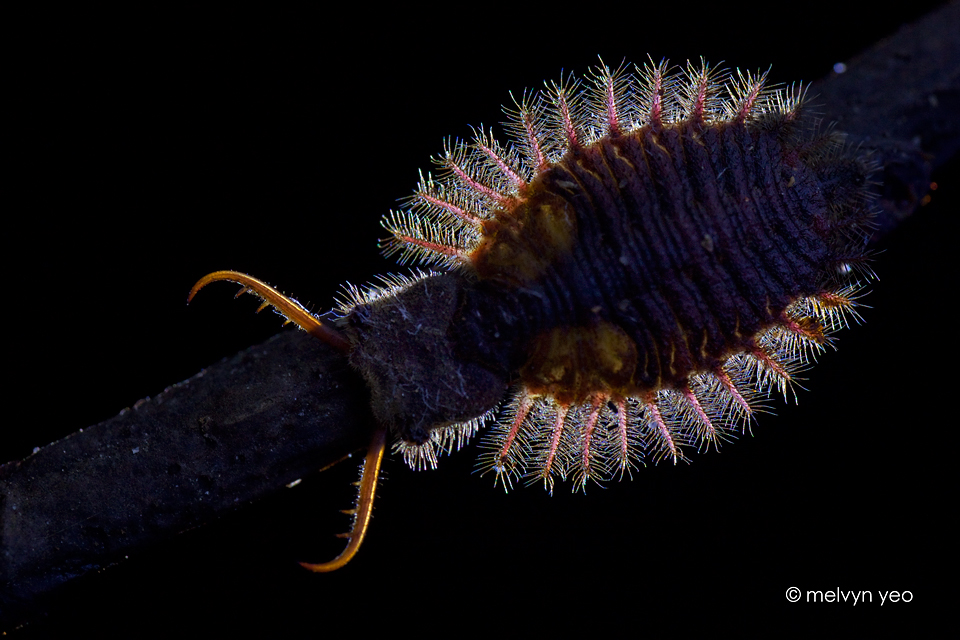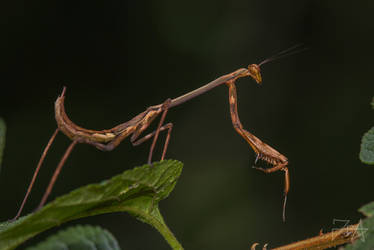ShopDreamUp AI ArtDreamUp
Deviation Actions
Description
A beautiful larva! Taken at night in Singapore.
Closeup
Quote en.wikipedia.org/wiki/Owlfly
Owlflies are dragonfly-like insects with large bulging eyes and long knobbed antennae. They are neuropterans in the family Ascalaphidae; they are only distantly related to the true flies, and even more distant from the dragonflies and damselflies. They are diurnal or crepuscular predators of other flying insects, and are typically 5 cm (2.0 in) long.
Adult owlflies are aerial predators feeding on other insects. When disturbed, some owlflies will release a strong, musk-like chemical to deter enemies. Adults of many New World species are most active at sunset and dawn and can often be collected around lights. During the day, such adults rest on stems and twigs with the body, legs, and antennae pressed to the stem. The abdomen in a few species is held up, projecting into the air, to look like a broken twig. Many Old World species, however, are most active during the day, and are brightly colored – many even hold their wings spread at rest like dragonflies; perhaps this is a form of mimicry to benefit from the fact that dragonflies are aggressive predators which smaller predatory insects (for which the average neuropteran would be prey) would be better to avoid. Most owlflies average about 2 inches in length.[2] Adult Ascalaphinae such as Ululodes have large divided eyes, which is where the common name "owlfly" came from,[2] in addition to their crepuscular habits. Owlflies are worldwide in distribution, though in North America they are primarily southerly.
Eggs are laid on twigs or under stones. Larvae are predatory, and lie on the ground or in vegetation, covered with debris, waiting for prey. Larvae resemble those of antlions, but have a "finger-like appendage" on the side of each segment. Some genera actively cement sand and debris onto their bodies as camouflage. Pupation occurs in a spheroidal silk cocoon in leaf litter.
Closeup

Quote en.wikipedia.org/wiki/Owlfly
Owlflies are dragonfly-like insects with large bulging eyes and long knobbed antennae. They are neuropterans in the family Ascalaphidae; they are only distantly related to the true flies, and even more distant from the dragonflies and damselflies. They are diurnal or crepuscular predators of other flying insects, and are typically 5 cm (2.0 in) long.
Adult owlflies are aerial predators feeding on other insects. When disturbed, some owlflies will release a strong, musk-like chemical to deter enemies. Adults of many New World species are most active at sunset and dawn and can often be collected around lights. During the day, such adults rest on stems and twigs with the body, legs, and antennae pressed to the stem. The abdomen in a few species is held up, projecting into the air, to look like a broken twig. Many Old World species, however, are most active during the day, and are brightly colored – many even hold their wings spread at rest like dragonflies; perhaps this is a form of mimicry to benefit from the fact that dragonflies are aggressive predators which smaller predatory insects (for which the average neuropteran would be prey) would be better to avoid. Most owlflies average about 2 inches in length.[2] Adult Ascalaphinae such as Ululodes have large divided eyes, which is where the common name "owlfly" came from,[2] in addition to their crepuscular habits. Owlflies are worldwide in distribution, though in North America they are primarily southerly.
Eggs are laid on twigs or under stones. Larvae are predatory, and lie on the ground or in vegetation, covered with debris, waiting for prey. Larvae resemble those of antlions, but have a "finger-like appendage" on the side of each segment. Some genera actively cement sand and debris onto their bodies as camouflage. Pupation occurs in a spheroidal silk cocoon in leaf litter.
Image size
960x640px 368.28 KB
© 2013 - 2024 melvynyeo
Comments12
Join the community to add your comment. Already a deviant? Log In
Perfect timing/angle/lighting!!
































